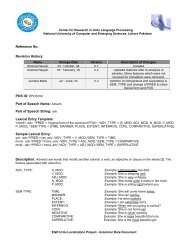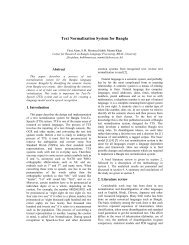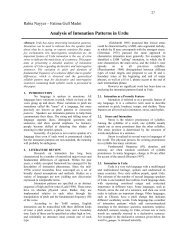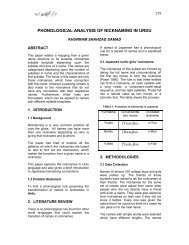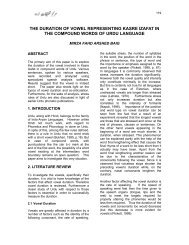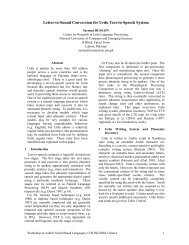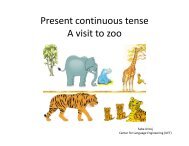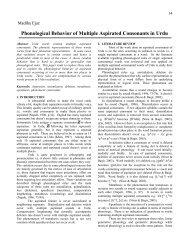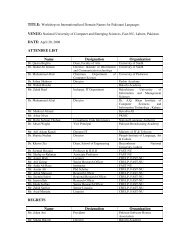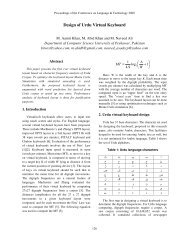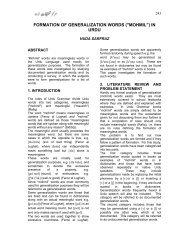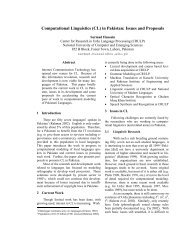Corpus Based Urdu Lexicon Development
Corpus Based Urdu Lexicon Development
Corpus Based Urdu Lexicon Development
You also want an ePaper? Increase the reach of your titles
YUMPU automatically turns print PDFs into web optimized ePapers that Google loves.
Figure 2: <strong>Urdu</strong> digits<br />
Special symbols that may occur in <strong>Urdu</strong> text are<br />
shown in Figure 3. Their details can be found in Arabic<br />
script block in Unicode<br />
(http://www.unicode.org/charts/).<br />
Figure 3: <strong>Urdu</strong> special symbols<br />
The following sections discuss some issues that arise<br />
due to Unicode and <strong>Urdu</strong> orthography.<br />
2.1. Unicode Variations<br />
The Unicode standard provides almost complete<br />
support for <strong>Urdu</strong>. However, there are a few<br />
discrepancies, for example in Unicode, the character<br />
Hamza (ء) is declared a non-joiner (i.e. it does not<br />
connect with the letter following it). However, in <strong>Urdu</strong><br />
language words e.g., قائل / kɑ.ɪl / require a Hamza to be<br />
joined with the characters following it. For such words<br />
Unicode provides a separate character ئ (joining<br />
Hamza) instead of .ء Similarly, the character Bari Yay<br />
is also considered a non-joiner in Unicode (with the (ے)<br />
following character), but the word بے کار /be.kɑr/<br />
(adjective: “useless”). is also commonly written in <strong>Urdu</strong><br />
ی /be.kɑr/. To write the latter, we need to put بيکار as<br />
instead of ے so that the Yay joins with Kaaf .ک These<br />
issues still need to be resolved with the Unicode<br />
standard for complete <strong>Urdu</strong> support.<br />
Some characters like ک، ہ، ی، etc. have more than<br />
one Unicode value in different keyboards. Such<br />
characters are replaced by one standard character<br />
(depending on their position within the word) in order to<br />
normalize them before any processing is done on them.<br />
Appendix A provides the currently handled characters<br />
for normalization.<br />
2.2. Optional vocalic content<br />
<strong>Urdu</strong> is normally written only with letters, diacritics<br />
being optional. However, the letters represent just the<br />
consonantal content of the string and in some cases<br />
(under-specified) vocalic content. The vocalic content<br />
may be optionally or completely specified by using<br />
diacritics with the letters [1]. Every word has a correct<br />
set of diacritics, however, it can be written with or with<br />
out any diacritics at all, therefore, completely or<br />
partially omitting the diacritics of a word is permitted.<br />
In certain cases, two different words (with different<br />
pronunciations) may have exactly the same form if the<br />
diacritics are removed, but even in that case writing<br />
words without diacritics is permitted. One such example<br />
is given below:<br />
(swim) /t̪ær/ تَير<br />
/t̪ir/ (arrow)<br />
However, there are exceptions to this general<br />
behavior, certain words in <strong>Urdu</strong> require minimal<br />
diacritics without which they are considered incomplete<br />
and cannot be correctly read or pronounced. Some of<br />
these words are shown in Table 2.<br />
تِير<br />
Actual word<br />
/ɑ.lɑ/<br />
English<br />
translation<br />
High quality<br />
With<br />
diacritics<br />
(correct)<br />
اعلٰی<br />
/ɑ.lɑ/<br />
Without<br />
diacritics<br />
(incorrect)<br />
اعلی<br />
/ɑ.li/<br />
تقريبا<br />
تقريباً<br />
۔<br />
۰ ۱ ۲ ۳ ۴ ۵ ۶ ۷ ۸ ۹<br />
٪<br />
/t̪əq.ri.bən/<br />
almost<br />
/t̪əq.ri.bən/<br />
/t̪əq.ri.bɑ/<br />
Table 2: Some <strong>Urdu</strong> words that require<br />
diacritics<br />
2.3. Proper name identification and spelling<br />
variation<br />
In <strong>Urdu</strong>, there is no concept of capitalization. Proper<br />
names cannot be identified through script analysis and<br />
there is no ‘<strong>Urdu</strong> specific’ algorithm for named entity<br />
tagging.<br />
Spelling variations are quite common in <strong>Urdu</strong>. The<br />
main reason for these variations is that there are many<br />
homophone characters (different letters representing the<br />
same phoneme) in <strong>Urdu</strong>. Also people tend to confuse<br />
different homophones for each other, so, as a result,<br />
incorrect spelling of words having homophones<br />
becomes quite common. For example, ”ز“ and ”ذ“ are<br />
homophone characters and are very frequently confused<br />
with each other. The word ”پذير“ /pə.zir/ is commonly<br />
written in news papers, books and some dictionaries<br />
with letter ”ز“ instead of ,”ذ“ which is correct.<br />
<strong>Urdu</strong> collation sequence is fully standardized. In<br />
<strong>Urdu</strong>, three levels of sorting are required for letters,<br />
2


